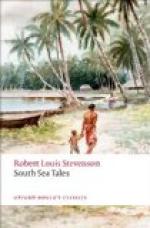Taahauku, on the south-westerly coast of the island of Hiva-oa— Tahuku, say the slovenly whites—may be called the port of Atuona. It is a narrow and small anchorage, set between low cliffy points, and opening above upon a woody valley: a little French fort, now disused and deserted, overhangs the valley and the inlet. Atuona itself, at the head of the next bay, is framed in a theatre of mountains, which dominate the more immediate settling of Taahauku and give the salient character of the scene. They are reckoned at no higher than four thousand feet; but Tahiti with eight thousand, and Hawaii with fifteen, can offer no such picture of abrupt, melancholy alps. In the morning, when the sun falls directly on their front, they stand like a vast wall: green to the summit, if by any chance the summit should be clear—water-courses here and there delineated on their face, as narrow as cracks. Towards afternoon, the light falls more obliquely, and the sculpture of the range comes in relief, huge gorges sinking into shadow, huge, tortuous buttresses standing edged with sun. At all hours of the day they strike the eye with some new beauty, and the mind with the same menacing gloom.
The mountains, dividing and deflecting the endless airy deluge of the Trade, are doubtless answerable for the climate. A strong draught of wind blew day and night over the anchorage. Day and night the same fantastic and attenuated clouds fled across the heavens, the same dusky cap of rain and vapour fell and rose on the mountain. The land-breezes came very strong and chill, and the sea, like the air, was in perpetual bustle. The swell crowded into the narrow anchorage like sheep into a fold; broke all along both sides, high on the one, low on the other; kept a certain blowhole sounding and smoking like a cannon; and spent itself at last upon the beach.
On the side away from Atuona, the sheltering promontory was a nursery of coco-trees. Some were mere infants, none had attained to any size, none had yet begun to shoot skyward with that whip-like shaft of the mature palm. In the young trees the colour alters with the age and growth. Now all is of a grass-like hue, infinitely dainty; next the rib grows golden, the fronds remaining green as ferns; and then, as the trunk continues to mount and to assume its final hue of grey, the fans put on manlier and more decided depths of verdure, stand out dark upon the distance, glisten against the sun, and flash like silver fountains in the assault of the wind. In this young wood of Taahauku, all these hues and combinations were exampled and repeated by the score. The trees grew pleasantly spaced upon a hilly sward, here and there interspersed with a rack for drying copra, or a tumble-down hut for storing it. Every here and there the stroller had a glimpse of the Casco tossing in the narrow anchorage below; and beyond he had ever before him the dark amphitheatre of the Atuona mountains and the cliffy bluff that closes it to seaward. The trade-wind moving in the fans made a ceaseless noise of summer rain; and from time to time, with the sound of a sudden and distant drum-beat, the surf would burst in a sea-cave.




